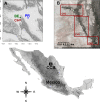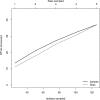Microfungal oasis in an oligotrophic desert: diversity patterns and community structure in three freshwater systems of Cuatro Ciénegas, Mexico
- PMID: 27280070
- PMCID: PMC4893334
- DOI: 10.7717/peerj.2064
Microfungal oasis in an oligotrophic desert: diversity patterns and community structure in three freshwater systems of Cuatro Ciénegas, Mexico
Abstract
The Cuatro Ciénegas Basin (CCB) comprises several oligotrophic aquatic ecosystems limited by phosphorus. These aquatic systems are dominated by a high prokaryotic diversity, shaped by the stress of low nutrient supplies and interspecific competition. Although fungi constitute a diverse and important component of microbial diversity, the microfungal diversity in the CCB remains to be unveiled. With the aim to explore microfungal diversity and ecological patterns in this area, we present the first investigation analyzing cultivable taxa from sediment and water, as well as lignocellulolytic taxa obtained from incubated submerged plant debris, and wood panels in three contrasting freshwater systems in the CCB: Churince, Becerra and Pozas Rojas. We chose a culture-based approach to analyze sediment and water samples in order to obtain fungal cultures, providing opportunities for a posteriori studies, and the possibility of ex situ preservation of the diversity. We evaluated sequence data from the nuclear ribosomal internal transcribed spacer including the 5.8 rDNA region for 126 isolates, revealing 37 OTUs. These OTUs were phylogenetically affiliated to several genera in the fungal phyla: Zygomycota, Basidiomycota, and Ascomycota. We recorded two OTUs with saline affinity, agreeing with previous findings on the prokaryotic communities with ancestral marine resemblances. All the studied systems showed moderate diversity levels, however discrepancies among the diversity indexes were observed, due to the occurrence of abundant taxa in the samples. Our results indicated that lignocellulolytic microfungal communities are dominated by transient fungal taxa, as resident species were not recorded perhaps as a result of the long-term strong competition with the highly adapted prokaryotic community. Moreover, the obtained microfungal taxa occurred mostly on the resident plant debris, rather than submerged wood panels, perhaps as a result of the high adaptation to specific environmental conditions. In conclusion, the CCB possess a moderate taxonomical diversity compared to other arid environments, probably as a result of high selective pressures. Nonetheless, due to high spatial and temporal heterogeneity, the functional fungal diversity was considerable as predicted by the intermediate disturbance hypothesis. Decisively, the assessment of microfungal diversity freshwater systems is relevant, since this ecological group of microorganisms represents an important indicator of trophic complexity and biotic interactions among microbial communities, having important implications for understanding eukaryotic survival at the oligotrophic limit for life.
Keywords: Ascomycota; Biodiversity; Facultative aquatic fungi; Oasis mycobiota; Plant debris; Submerged wood baits.
Conflict of interest statement
Valeria Souza and Luis E. Eguiarte are Academic Editors for PeerJ.
Figures










Similar articles
-
The Geographic Structure of Viruses in the Cuatro Ciénegas Basin, a Unique Oasis in Northern Mexico, Reveals a Highly Diverse Population on a Small Geographic Scale.Appl Environ Microbiol. 2018 May 17;84(11):e00465-18. doi: 10.1128/AEM.00465-18. Print 2018 Jun 1. Appl Environ Microbiol. 2018. PMID: 29625974 Free PMC article.
-
High diversity and suggested endemicity of culturable Actinobacteria in an extremely oligotrophic desert oasis.PeerJ. 2017 May 2;5:e3247. doi: 10.7717/peerj.3247. eCollection 2017. PeerJ. 2017. PMID: 28480140 Free PMC article.
-
Microbial secondary succession in soil microcosms of a desert oasis in the Cuatro Cienegas Basin, Mexico.PeerJ. 2013 Mar 5;1:e47. doi: 10.7717/peerj.47. Print 2013. PeerJ. 2013. PMID: 23638384 Free PMC article.
-
The Cuatro Ciénegas Basin in Coahuila, Mexico: an astrobiological Precambrian Park.Astrobiology. 2012 Jul;12(7):641-7. doi: 10.1089/ast.2011.0675. Astrobiology. 2012. PMID: 22920514 Free PMC article. Review.
-
Ectomycorrhizal lifestyle in fungi: global diversity, distribution, and evolution of phylogenetic lineages.Mycorrhiza. 2010 Apr;20(4):217-63. doi: 10.1007/s00572-009-0274-x. Epub 2009 Sep 16. Mycorrhiza. 2010. PMID: 20191371 Review.
Cited by
-
Microbial diversity of the remote Trindade Island, Brazil: a systematic review.PeerJ. 2025 Apr 30;13:e19305. doi: 10.7717/peerj.19305. eCollection 2025. PeerJ. 2025. PMID: 40321823 Free PMC article.
-
Nutrient Dependent Cross-Kingdom Interactions: Fungi and Bacteria From an Oligotrophic Desert Oasis.Front Microbiol. 2018 Aug 6;9:1755. doi: 10.3389/fmicb.2018.01755. eCollection 2018. Front Microbiol. 2018. PMID: 30131780 Free PMC article.
-
Systematic bioprospection for cellulolytic actinomycetes in the Chihuahuan Desert: isolation and enzymatic profiling.PeerJ. 2023 Sep 28;11:e16119. doi: 10.7717/peerj.16119. eCollection 2023. PeerJ. 2023. PMID: 37790635 Free PMC article.
-
Experimental and molecular approximation to microbial niche: trophic interactions between oribatid mites and microfungi in an oligotrophic freshwater system.PeerJ. 2018 Jul 11;6:e5200. doi: 10.7717/peerj.5200. eCollection 2018. PeerJ. 2018. PMID: 30018858 Free PMC article.
-
Diversity of an uncommon elastic hypersaline microbial mat along a small-scale transect.PeerJ. 2022 Jun 20;10:e13579. doi: 10.7717/peerj.13579. eCollection 2022. PeerJ. 2022. PMID: 35757167 Free PMC article.
References
-
- Abarenkov K, Nilsson RH, Larsson KH, Alexander IJ, Eberhardt U, Erland S, Høiland K, Kjøller R, Larsson E, Pennanen T, Sen R, Taylor AFS, Tedersoo L, Ursing BM, Vrålstad T, Liimatainen K, Peintner U, Kõljalg U. The UNITE database for molecular identification of fungi–recent updates and future perspectives. New Phytologist. 2010;186:281–285. doi: 10.1111/j.1469-8137.2009.03160.x. - DOI - PubMed
-
- Abdel-Hafez SII. Survey of the mycoflora of desert soils in Saudi Arabia. Mycopathologia. 1982a;80:3–8. doi: 10.1007/BF00437171. - DOI
-
- Abdel-Hafez SII. Osmophilic fungi of desert soils in Saudi Arabia. Mycopathologia. 1982b;80:9–14. doi: 10.1007/BF00437172. - DOI
-
- Abdullah SK, Al-Bader SM. On the thermophilic and thermotolerant mycoflora of Iraqi soils. Sydowia. 1990;42:1–7.
LinkOut - more resources
Full Text Sources
Other Literature Sources
Molecular Biology Databases

